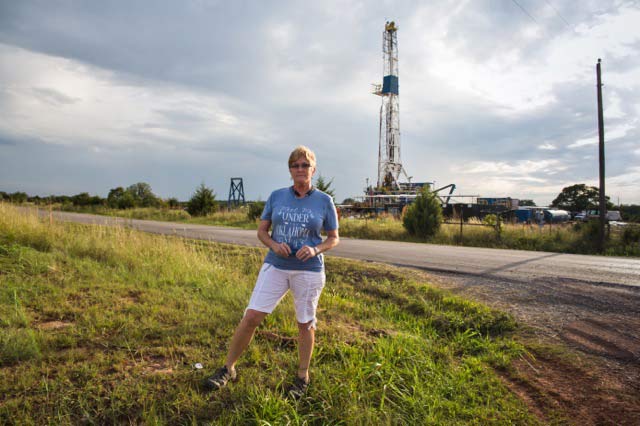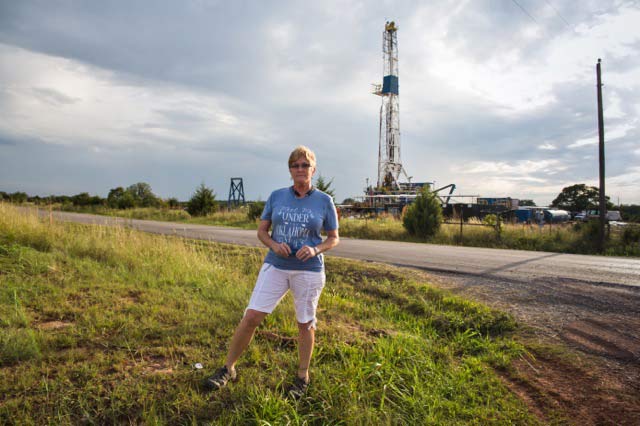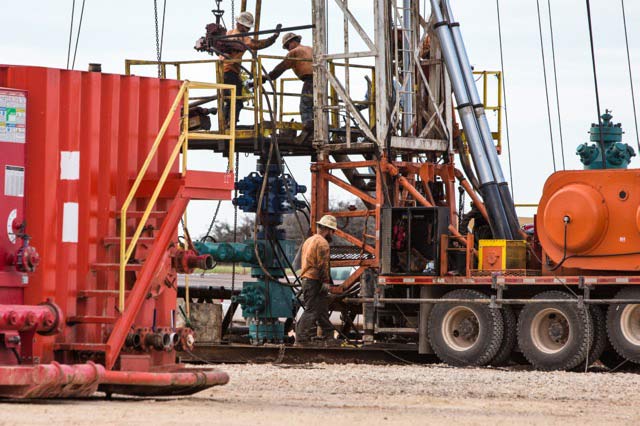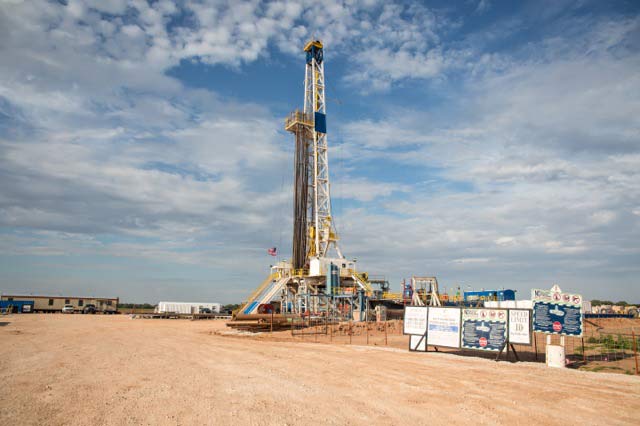
As Oklahoma continues to experience more earthquakes than California this year, residents are questioning why regulators haven’t taken any meaningful action to guard against increased seismic activity.
The US Geological Survey (USGS) says that wastewater injection into deep geologic formations, a part of the hydraulic fracturing (fracking) process, is a likely contributing factor to this increase in quakes. The phenomenon, known as “injection-induced seismicity,” has been documented for nearly half a century, according to the USGS.
“The rate of earthquakes in Oklahoma has increased remarkably since October 2013 — by about 50 per cent — significantly increasing the chance for a damaging magnitude 5.5 or greater quake in central Oklahoma,” says the USGS report.
Angela Spotts is one of many Oklahoma residents who is wondering why no meaningful action has been taken to safeguard residents.
 Angela Spotts across from a drilling rig at a hydraulic fracturing site near her home. ©2014 Julie Dermansky
Angela Spotts across from a drilling rig at a hydraulic fracturing site near her home. ©2014 Julie Dermansky
“It is kind of like an assault. You feel like you are being sacrificed for this gold they are pulling out of the ground. And you start meeting people that are getting sick,” Spotts, a member of Stop Fracking Payne County, told DeSmogBlog. “It is the tobacco industry all over again.”
 Drilling rig in Stillwater County, near Angela Spotts home. ©2014 Julie Dermansky
Drilling rig in Stillwater County, near Angela Spotts home. ©2014 Julie Dermansky
When oil and gas companies use a method called hydraulic fracturing, or “fracking,” they blast a high-pressure chemical concoction underground to break apart rock to release oil and gas. This process results in high volumes of toxic wastewater that is disposed of by injecting it at high pressures deep under ground into what are known as wastewater injection wells. These disposal wells can lubricate subterranean faults, causing earthquakes.
There have been more than 400 magnitude 3.0 or greater earthquakes in Oklahoma this year, coinciding with a fracking boom in Central and Northern Oklahoma, and across the state line in southern Kansas. Stop Fracking Payne County counts 480 earthquakes over magnitude 3.0 as of today. The group’s figures are derived by following Oklahoma’s USGS site.
“This isn’t new science,” Oklahoma State University geology professor Todd Halihan told DeSmogBlog.
What is new is how we deal with science that is coupled with uncertainty, he says. Though scientists can link injection well use to earthquakes, linking a specific well to a specific quake is not possible.
“Uncertainty used to be a reason we would slow things down and now uncertainly is being used to avoid things,” Halihan says.
He fears that if no action is taken and there is a catastrophic quake, lives will be lost and, in the disaster’s aftermath, industry in the area could be shut down completely.
“The options for moving forward in effective ways are not being taken,” Halihan said.
Though Halihan doesn’t believe there is a need to shut down all the wells, “taking high volume ones [wells] off line or lowering their rates is advisable. If seismicity is reduced or stops completely in the following months, a connection could be verified.”
The Oklahoma Corporation Commission, the agency that regulates the oil and gas industry in Oklahoma, stopped operations at an injection well thought to have caused a 4.3 magnitude earthquake near Cushing in October. Yet the commission still fails to embrace the science.
A bipartisan interim study undertaken at the request of state representativesJason Murphey (R-Guthrie) and Cory Williams (D-Stillwater), whose districts are in areas with high levels of seismic activity, was presented at the state capitol on October 28.
During the hearing, politicians questioned regulators and scientists who outlined the progress of research into the increased incidence of earthquakes in Oklahoma. After reviewing the data, the state is expected to write new legislation regarding wastewater injection well use.
“The study reassured us that the Corporation Commission and governor’s Coordinating Council are working hard to research and oversee injection wells in Oklahoma,” State Rep. Mark McBride (R-Moore) said.
“Currently, there is no scientific evidence that there is a correlation between the injection wells and seismic activity,” states a press release from Moore.
Yet Halihan presented information during the hearing that says otherwise. And you’d think the US Geological Survey would count as a pretty reputable source.
Since the study, notable seismic events have rattled the state including five quakes that struck within minutes of each other on November 9 and a 4.8 earthquake on November 12 near Conway Springs, Kansas, that was felt in Oklahoma and Arkansas.
The Oklahoma regulatory agency is not alone in ignoring the science that links earthquakes to injection well use. The Texas Railroad Commission came up with new rules to deal with injection wells after an earthquake swarm rattled cities west of Fort Worth. The commission’s new rules fail to acknowledge a connection between injection wells and seismic activity and are similar to new rules set in Oklahoma.
The connection between the fracking process and earthquakes is likely contributing to seismicity as well, according to Cliff Frohlich, associate director and senior research scientist at the Institute of Geophysics at the University of Texas at Austin.
“In the last year there have been three well-documented earthquakes that occurred during frack jobs and were probably related to fracking. They were all small earthquakes — of a magnitude of 2 or 3 — and, considering that there are millions of frack jobs, fracking-related earthquakes are rare,” Frohlich told NPR’s StateImpact Texas.
Sara Winsted, a resident of Edmond, an upscale Oklahoma City suburb, finds the quakes terrifying and is frustrated with politicians in both parties for failing to act beyond asking for further study.
“It isn’t a Democratic or Republican issue. It is an earthquake fracking issue. Republicans are feeling the same earthquakes the liberals are,” she told DeSmogBlog.
She downloaded apps on her phone to follow the activity, but many of the quakes don’t show up, so she calls them in to the USGS.
“There are many more than the USGS is reporting,” she says.
 An app on Sara Winsted’s phone shows her earthquakes around the world. ©2014 Julie Dermansky
An app on Sara Winsted’s phone shows her earthquakes around the world. ©2014 Julie Dermansky
Regulators in Oklahoma continue monitoring the situation while refusing to acknowledge the connection between fracking and earthquakes. Halihan points out there are psychological studies that show people only support science that supports their beliefs.
“Science has become an opinion, versus a process that looks at data from a neutral perspective,” he says.
 Drilling rig in Stillwater County, Oklahoma, near Angela Spotts’ home. ©2104 Julie Dermansky
Drilling rig in Stillwater County, Oklahoma, near Angela Spotts’ home. ©2104 Julie Dermansky
We have 10 days to raise $50,000 — we’re counting on your support!
For those who care about justice, liberation and even the very survival of our species, we must remember our power to take action.
We won’t pretend it’s the only thing you can or should do, but one small step is to pitch in to support Truthout — as one of the last remaining truly independent, nonprofit, reader-funded news platforms, your gift will help keep the facts flowing freely.